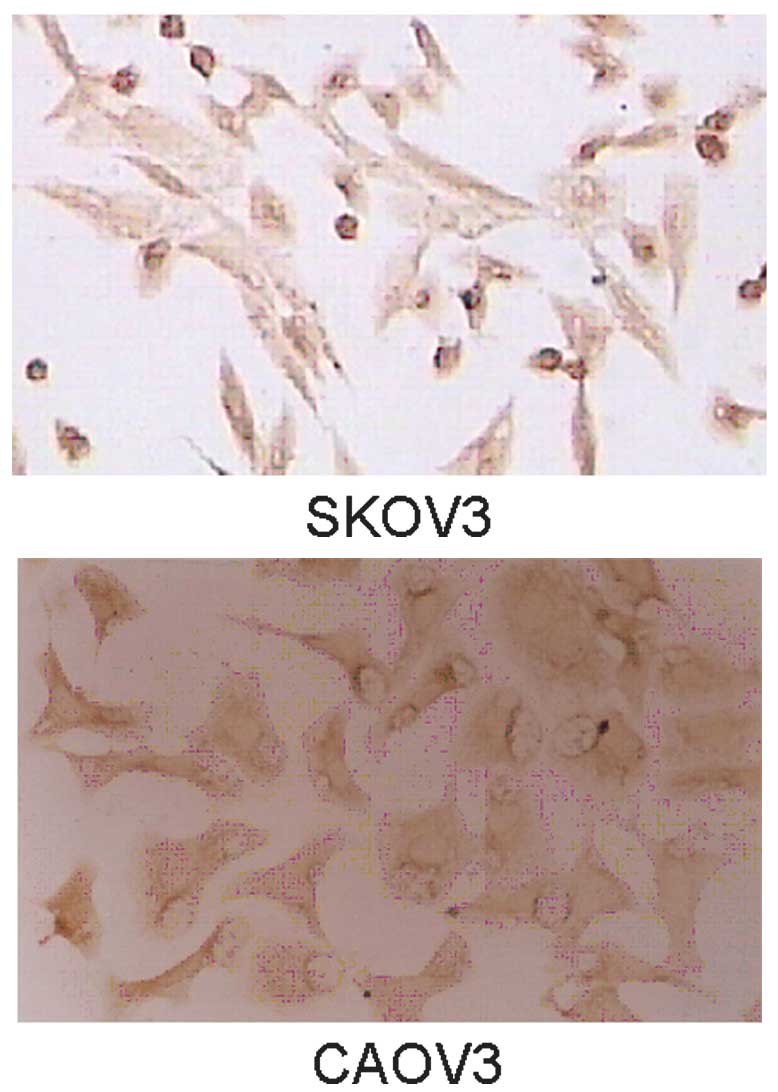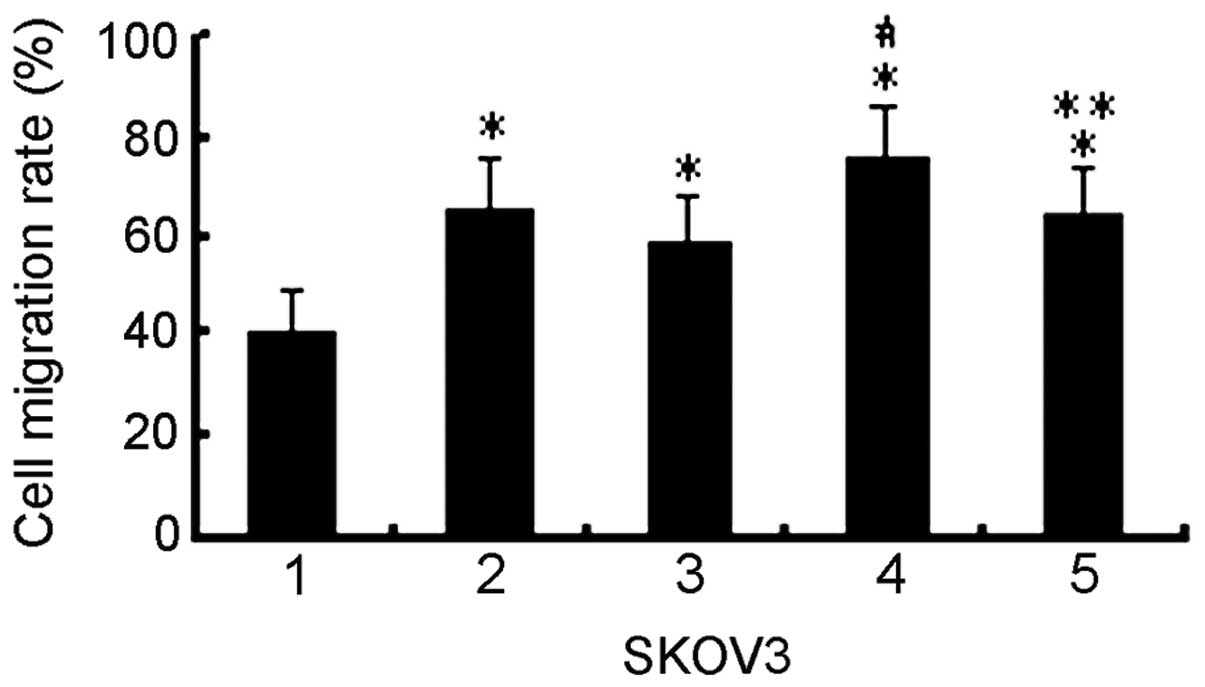|
1
|
Xu Y, Gaudette DC, Boynton JD, et al:
Characterization of an ovarian cancer activating factor in ascites
from ovarian cancer patients. Clin Cancer Res. 1:1223–1232.
1995.PubMed/NCBI
|
|
2
|
Xu Y, Shen Z, Wiper DW, et al:
Lysophosphatidic acid as a potential biomarker for ovarian and
other gynecologic cancers. JAMA. 280:719–723. 1998. View Article : Google Scholar
|
|
3
|
Hu YL, Albanese C, Pestell RG and Jaffe
RB: Dual mechanisms for lysophosphatidic acid stimulation of human
ovarian carcinoma cells. J Natl Cancer Inst. 95:733–740. 2003.
View Article : Google Scholar : PubMed/NCBI
|
|
4
|
Frankel A and Mills GB: Peptide and lipid
growth factors decrease cis-diamminedichloroplatinum-induced cell
death in human ovarian cancer cells. Clin Cancer Res. 2:1307–1313.
1996.PubMed/NCBI
|
|
5
|
Pustilnik TB, Estrella V, Wiener JR, et
al: Lysophosphatidic acid induces urokinase secretion by ovarian
cancer cells. Clin Cancer Res. 5:3704–3710. 1999.PubMed/NCBI
|
|
6
|
Fujita T, Miyamoto S, Onoyama I, Sonoda K,
Mekada E and Nakano H: Expression of lysophosphatidic acid
receptors and vascular endothelial growth factor mediating
lysophosphatidic acid in the development of human ovarian cancer.
Cancer Lett. 192:161–169. 2003. View Article : Google Scholar
|
|
7
|
Fishman DA, Liu Y, Ellerbroek SM and Stack
MS: Lysophosphatidic acid promotes matrix metalloproteinase (MMP)
activation and MMP-dependent invasion in ovarian cancer cells.
Cancer Res. 61:3194–3199. 2001.PubMed/NCBI
|
|
8
|
So J, Navari J, Wang FQ and Fishman DA:
Lysophosphatidic acid enhances epithelial ovarian carcinoma
invasion through the increased expression of interleukin-8. Gynecol
Oncol. 95:314–322. 2004. View Article : Google Scholar : PubMed/NCBI
|
|
9
|
Symowicz J, Adley BP, Woo MM, Auersperg N,
Hudson LG and Stack MS: Cyclooxygenase-2 functions as a downstream
mediator of lysophosphatidic acid to promote aggressive behavior in
ovarian carcinoma cells. Cancer Res. 65:2234–2242. 2005. View Article : Google Scholar
|
|
10
|
Scotton CJ, Wilson JL, Milliken D, Stamp G
and Balkwill FR: Epithelial cancer cell migration: a role for
chemokine receptors? Cancer Res. 61:4961–4965. 2001.PubMed/NCBI
|
|
11
|
Scotton CJ, Wilson JL, Scott K, et al:
Multiple actions of the chemokine CXCL12 on epithelial tumor cells
in human ovarian cancer. Cancer Res. 62:5930–5938. 2002.
|
|
12
|
Dewan MZ, Ahmed S, Iwasaki Y, Ohba K, Toi
M and Yamamoto N: Stromal cell-derived factor-1 and CXCR4 receptor
interaction in tumor growth and metastasis of breast cancer. Biomed
Pharmacother. 60:273–276. 2006. View Article : Google Scholar
|
|
13
|
Jiang YP, Wu XH, Shi B, Wu WX and Yin GR:
Expression of chemokine CXCL12 and its receptor CXCR4 in human
epithelial ovarian cancer: an independent prognostic factor for
tumor progression. Gynecol Oncol. 103:226–233. 2006. View Article : Google Scholar : PubMed/NCBI
|
|
14
|
Jemal A, Thomas A, Murray T and Thun M:
Cancer statistics, 2002. CA Cancer J Clin. 52:23–47. 2002.
View Article : Google Scholar
|
|
15
|
Popple A, Durrant LG, Spendlove I, et al:
The chemokine, CXCL12, is an independent predictor of poor survival
in ovarian cancer. Br J Cancer. 106:1306–1313. 2012. View Article : Google Scholar
|
|
16
|
Müller A, Homey B, Soto H, et al:
Involvement of chemokine receptors in breast cancer metastasis.
Nature. 410:50–56. 2001.PubMed/NCBI
|
|
17
|
Phillips RJ, Burdick MD, Lutz M, Belperio
JA, Keane MP and Strieter RM: The stromal derived
factor-1/CXCL12-CXC chemokine receptor 4 biological axis in
non-small cell lung cancer metastases. Am J Respir Crit Care Med.
167:1676–1686. 2003. View Article : Google Scholar : PubMed/NCBI
|
|
18
|
Cooper CR, Chay CH, Gendernalik JD, et al:
Stromal factors involved in prostate carcinoma metastasis to bone.
Cancer. 97(3 Suppl): 739–747. 2003. View Article : Google Scholar : PubMed/NCBI
|
|
19
|
Kryczek I, Wei S, Keller E, Liu R and Zou
W: Stroma-derived factor (SDF-1/CXCL12) and human tumor
pathogenesis. Am J Physiol Cell Physiol. 292:C987–C995. 2007.
View Article : Google Scholar : PubMed/NCBI
|
|
20
|
Guo L, Cui ZM, Zhang J and Huang Y:
Chemokine axes CXCL12/CXCR4 and CXCL16/CXCR6 correlate with lymph
node metastasis in epithelial ovarian carcinoma. Chin J Cancer.
30:336–343. 2011. View Article : Google Scholar : PubMed/NCBI
|
|
21
|
Daaka Y: Mitogenic action of LPA in
prostate. Biochim Biophys Acta. 1582:265–269. 2002. View Article : Google Scholar : PubMed/NCBI
|
|
22
|
Gräler MH and Goetzl EJ: Lysophospholipids
and their G protein-coupled receptors in inflammation and immunity.
Biochim Biophys Acta. 1582:168–174. 2002.PubMed/NCBI
|
|
23
|
Ren J, Xiao YJ, Singh LS, et al:
Lysophosphatidic acid is constitutively produced by human
peritoneal mesothelial cells and enhances adhesion, migration, and
invasion of ovarian cancer cells. Cancer Res. 66:3006–3014. 2006.
View Article : Google Scholar
|
|
24
|
Moolenaar WH: Bioactive lysophospholipids
and their G protein-coupled receptors. Exp Cell Res. 253:230–238.
1999. View Article : Google Scholar : PubMed/NCBI
|
|
25
|
Ishii S, Noguchi K and Yanagida K: Non-Edg
family lysophosphatidic acid (LPA) receptors. Prostaglandins Other
Lipid Mediat. 89:57–65. 2009. View Article : Google Scholar : PubMed/NCBI
|
|
26
|
Yanagida K, Kurikawa Y, Shimizu T and
Ishii S: Current progress in non-Edg family LPA receptor research.
Biochim Biophys Acta. 1831:33–41. 2013. View Article : Google Scholar : PubMed/NCBI
|
|
27
|
Gunther EC, von Bartheld CS, Goodman LJ,
Johnson JE and Bothwell M: The G-protein inhibitor, pertussis
toxin, inhibits the secretion of brain-derived neurotrophic factor.
Neuroscience. 100:569–579. 2000. View Article : Google Scholar : PubMed/NCBI
|

















